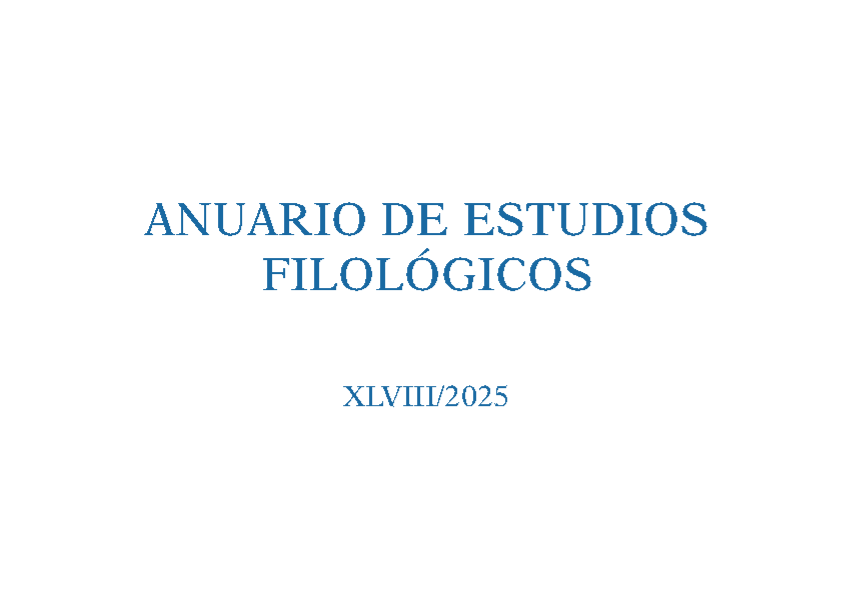"We make guilty of our disasters the sun, the moon, and the stars": una cartografía semántica del lenguaje astronómico de Shakespeare
DOI:
https://doi.org/10.17398/2660-7301.48.281Palabras clave:
Shakespeare, Semántica, Léxico, AstronomíaResumen
El lenguaje de Shakespeare ha sido objeto de estudio y análisis durante siglos, incluso de monografías sobre los campos semánticos más dispares, como la botánica, la geografía, el comercio, etc. En este sentido, el lenguaje astronómico no es una excepción. Sin embargo, los estudios existentes sobre el lenguaje astronómico de Shakespeare o bien se han inclinado hacia el campo de la astrología y el simbolismo de lo oculto, o bien se han centrado en glosar pasajes y términos concretos, normalmente para desentrañar el valor científico de las referencias astronómicas. Por lo tanto, no existe un relato sistemático de la semántica de estos términos. Así pues, el propósito de este estudio es proporcionar un análisis holístico de los tres términos más comunes con un significado estrictamente astronómico en el léxico de Shakespeare; a saber, ‘sol’, ‘luna’ y ‘estrella/s’. El análisis traza aquí la semántica de estos términos indagando en los significados recurrentes que adoptan. Esto, a su vez, abre una nueva vía de investigación sobre el uso estilístico de los cuerpos astronómicos en formas que incluyen la delineación de personajes, el desarrollo de la trama, la estructura dramática, la caracterización de género y el papel del lenguaje figurado.
Descargas
Referencias
ADAMSON, Sylvia (1999): «Literary Language». In Lass, Roger (ed.): The Cambridge History of the English Language. Volume III: 1476 to 1776. Cambridge: CUP, 539-653.
BEVINGTON, David (ed.) (1997): The Complete Works of Shakespeare. New York: Longman.
BEZZOLA LAMBERT, Ladina (2002): Imagining the Unimaginable: The Poetics of Early Modern Astronomy. Amsterdam: Rodopi.
CAMPION, Nicholas (2014): «The Legacy of Classical Cosmology in the Renaissance: Shakespeare and Astronomy». Mediterranean Archaeology and Archaeometry, 14.3, 331-339.
CONLEY, C. H. (1915): «An Instance of the Fifteen Signs of Judgment in Shakes-peare». Modern Language Notes, 30.2, 41-44 (https://doi.org/10.2307/2916899).
COSTELLO, Priscilla (2016): Shakespeare and the Stars: The Hidden Astrological Keys to Understanding the World’s Greatest Playwright. Lake Worth, FL: Ibis Press.
CULPEPER, Jonathan (2011): «A New Kind of Dictionary for Shakespeare’s Plays: An Immodest Proposal» (Ravassat & Culpeper, 2011: 58-83).
DASTON, Lorraine (1991): «Marvelous Facts and Miraculous Evidence in Early Modern Europe». Critical Inquiry, 18.1, 93-124.
DEAN, John Candee (1924): «The Astronomy of Shakespeare». The Scientific Monthly, 19.4, 400-406.
GERARD, John (1636): The Herball or Generall Historie of Plantes. London: Printed by A. Islip, J. Norton & R. Whitakers (available at: https://archive.org/details/herballorgeneral00gera).
GILLESPIE, Stuart & RHODES, Neil (2006): «Introduction: Shakespeare and Elizabethan Popular Culture». In Gillespie, Stuart & Rhodes, Neil (eds.): Shakespeare and Elizabethan Popular Culture. London: Bloomsbury, 1-17.
GLÄSER, Rosemarie (1998): «The Stylistic Potential of Phraseological Units in the Light of Genre Analysis». In Cowie, A. P. (ed.): Phraseology: Theory, Analysis, and Applications. Oxford: OUP, 125-143.
GUTHRIE, William Gilmour (1964): «The Astronomy of Shakespeare». The Irish Astronomical Journal, 6.6, 201-211.
HARMON, Orrin E. (1898): «The Astronomy of Shakespeare». Popular Astrono-my, 6, 232-233.
HOPE, Jonathan (2010): Shakespeare and Language: Reason, Eloquence and Artifice in the Renaissance. London: Bloomsbury.
JABLONSKI, Nina G. (2012): Living Color: The Biological and Social Meaning of Skin Color. Berkeley: University of California Press.
KANAZAWA, Satoshi & LI, Norman P. (2018): «The Savanna Theory of Happi-ness». In Hopcroft, Rosemary L. (ed.): The Oxford Handbook of Evolution, Biology, and Society. Oxford: OUP, 171-194 (https://doi.org/10.1093/oxfordhb/9780190299323.013.48).
LEVY, David H. (2011): The Sky in Early Modern English Literature: A Study of Allusions to Celestial Events in Elizabethan and Jacobean Writing, 1572–1620. New York: Springer.
LEVY, David H. & HAYDEN, Judy A. (2016): «An English Renaissance Astronomy Club? Shakespeare, Observation and the Cosmos». In Hayden, Judy A. (ed.): Literature in the Age of Celestial Discovery: From Copernicus to Flamsteed. New York: Palgrave, 75-90 (https://doi.org/10.1007/978-1-137-56803-8_4).
MCCORMICK-GOODHART, Leander (1945): «Shakespeare and the Stars». Popular Astronomy, 53.10, 489-502.
MUIR, Kenneth (1977): The Sources of Shakespeare’s Plays. New Haven: Yale University Press.
NACISCIONE, Anita (2010): Stylistic Use of Phraseological Units in Discourse. Amsterdam: John Benjamins.
OED = Oxford English Dictionary. Oxford: OUP (on-line: https://www.oed.com/).
OLSON, Donald W. (2014): Celestial Sleuth: Using Astronomy to Solve Mysteries in Art, History and Literature. New York: Springer (https://doi.org/10.1007/978-1-4614-8403-5).
PAOLUCCI, Anne (1977): «The Lost Days in A Midsummer Night’s Dream». Shakespeare Quarterly, 28.3, 317-326.
POPPER, Nicholas (2006): «“Abraham, Planter of Mathematics”: Histories of Mathematics and Astrology in Early Modern Europe». Journal of the History of Ideas, 67.1, 87-106.
RAVASSAT, Mireille (2011): «‘a thing inseparate/Divides more wider than the sky and earth’ – of Oxymoron in Shakespeare’s Sonnets» (Ravassat & Culpeper, 2011: 165-191).
RAVASSAT, Mireille & CULPEPER, Jonathan (eds.) (2011): Stylistics and Shakes-peare’s Language: Transdisciplinary Approaches. London: Continuum.
ROSS, Charles (1974): Edward IV. Berkeley: University of California Press.
SCHANZER, Ernest (1955): «The Moon and the Fairies in A Midsummer Night’s Dream». University of Toronto Quarterly, 24.3, 234-246.
SMIDT, Kristian (1986): Unconformities in Shakespeare’s Early Comedies. London: Macmillan.
SONDHEIM, Moriz (1939): «Shakespeare and the Astrology of His Time». Journal of the Warburg Institute, 2.3, 243-259.
USHER, Peter D. (2002): «Shakespeare’s Support for the New Astronomy». The Oxfordian, 5, 2-16.
USHER, Peter D. (2018): «Shakespeare’s Antony and Cleopatra and the New Astro-nomy». Notes and Queries, 65.1, 81-83 (https://doi.org/10.1093/notesj/gjx222).



